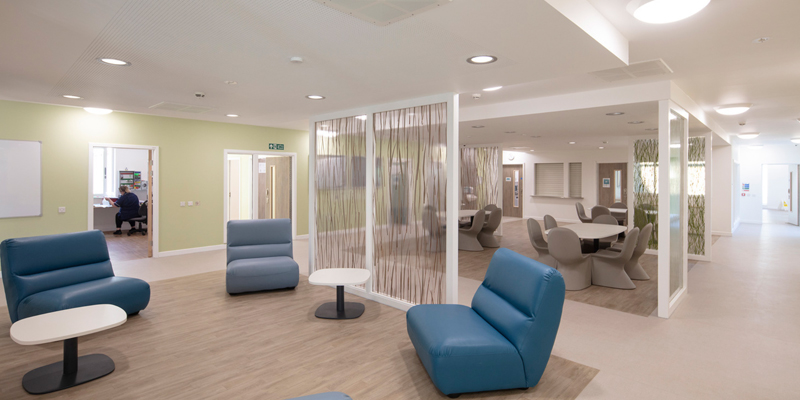
Mental Health Bedrooms – TVs ?
-
Mental Health Bedrooms – TVs ?
Posted by Morag on August 9, 2021 at 10:07 amI would be interested in the opinions of others on the pros and cons of TVs in mental health bedrooms- currently having this debate in Oz and wondered about others experiences
Jenny replied 2 years, 8 months ago 5 Members · 4 Replies -
4 Replies
-
I’ve often heard about bedroom TVs being recommended in one of the design guides but trying to remember where. I’ve never seen a TV being fitted in a bedroom, mainly due to cost reasons from anecdotal conversations with NHS teams.
From my own time in wards and speaking with patients, the communal TV lounge is an area of contention. Arguments over what channel to watch when there is only one TV for 10-20 people. I remember as a teenager the battles I had with just two siblings…
-
Recornect’s touchscreen (originated for seclusion rooms) can be configured for TV and radio, as well as any other function associated with mobile or tablet devices via a fully-managed backend. They published preliminary data indicating cost effectiveness, despite initial outlay, suggesting that improved social connectedness reduced length of stay. They have spoken and exhibited at DIMH, and usually attend though travel may compromise that this year. I will ask Cor and Erik to respond to this.
-
As a former psychiatric inpatient who has experienced multiple long admissions here are my thoughts on this. On the ward where I spent most of my admissions, each bedroom had it’s own small TV, there was also a larger TV in the communal lounge. Philip is right, communal lounges are not always particularly pleasant places to be and I avoided spending time in them as much as possible. There was rarely agreement about what should be on TV, usually the choice was made by a particularly dominant member of the group without much consultation with others. It was a rarity that something would be playing that I actually wanted to watch. Lounges are often exposed spaces, subject to (or sites of) disturbance happening within the ward. The lounge on my ward was also at the centre of a long corridor, the main thoroughfare for the ward. So it was impossible to watch the TV without doctors, nurses, visitors and patients constantly walking past the TV. In other words, if you really wanted to enjoy a particular programme in peace then the lounge was not the space to do it in.
However, the TVs we had in our bedrooms were frustratingly fitted at such a height and angle that it made it difficult to watch them in comfort. I remember being in one room where the TV was so poorly placed that the only way I could possibly see the screen was to sit in an uncomfortable position, with my head titled right back, in one particular spot on my bed. In my first admission TVs were mounted on brackets, which them easier to watch. These were later swapped for wall mounted TVs to remove the ligature point – however these were much harder to watch – again because they were often mounted high up on the wall and with little attention paid to where the most comfortable sightline might be. Due to my physical health I was often on bed rest whilst I was a patient. With small TVs mounted high up on the walls the TVs were not always that easy to see for someone lying in their bed.
So even though I had a TV in my bedroom I would often resort to watching things on my laptop instead. However, this in itself was an issue. When I was a patient we did not have wifi on the ward, so every time I was admitted I would have to pay for my pwn internet access using a plug-in device. This was an extra hassle and expense that I could have done without but I would have been lost without it. Most patients did the same.
I think that it is a good idea to have TVs in patient bedrooms. We often have few outlets to experience a sense of escape and for many patients watching their favourite programmes can bring a sense of routine, comfort and familiarity. Watching the news helped me to feel connected to the world outside. Watching documentaries about subjects which interested me helped me to feel connected to aspects of my identity which were sidelined when I came into hospital. Watching programmes my mum was also watching meant that I could talk to her about them and feel connected to her. Many patients used the TVs in their room to listen to the radio, so they served multiple functions. The problem is when the TVs are not incorporated into bedrooms in such a way that makes the viewing experience comfortable, or at times even feasible!
I’d be interested to hear more about the debate you’re having in Oz Morag – what are the pros and cons you’re discussing?
-
This is always a matter of debate. Many clinicians don’t want a TV in the bedroom because they want people to be out in the ward and not ‘hiding away’. If there are activities going on in the ward then people will come out of their rooms.
My view as a former service user and healthcare planner is that there should most definitely be a TV or some a Recornect in the bedroom. Like Katharine, I have seen more aggression and violence caused by a communal television, for example in a mixed ward the ladies want the cooking programmes and the gentlemen the sport.
Nowadays we are all used to having multiple channels on our television, to suddenly be restricted to one channel, usually dictated by the loudest voice, it is not conducive to recovery.
Log in to reply.

